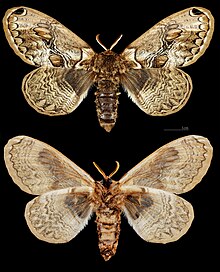Brahmaea europaea
| Brahmaea europaea | |
|---|---|

| |
| Scientific classification | |
| Domain: | Eukaryota |
| Kingdom: | Animalia |
| Phylum: | Arthropoda |
| Class: | Insecta |
| Order: | Lepidoptera |
| Family: | Brahmaeidae |
| Genus: | Brahmaea |
| Species: | B. europaea
|
| Binomial name | |
| Brahmaea europaea (Hartig, 1963)
| |
| Synonyms | |
| |
Brahmaea (Acanthobrahmaea) europaea, the European owl moth, is a
lepidopteran from the family Brahmaeidae, in the subgenus Acanthobrahmaea.[1]
Taxonomy
B. europaea is the sole species in the genus
Distribution and habitat

The species can only be found in southern
Life cycle
Adults fly from late March to early May. Adults are active after sunset and are cold-tolerant enough to be seen flying during snowfall.[1] Adults lay eggs on the trunks of plants within Oleaceae, including Fraxinus angustifolia, Phyllirea latifolia, and Ligustrum vulgare in captivity.[1]
Eggs hatch at the end of March and April 12 to 15 days after
pupate on the ground where they overwinter, and emerge as adults the following spring.[1]
References
- ^ a b c d e f g h i j Mosconi, F.; et al. (2014). "An overview of the most outstanding Italian endemic moth, Brahmaea (Acanthobrahmaea) europaea (Lepidoptera: Brahmaeidae)". Fragmenta Entomologica. 46: 1–9.
- ^ "Fauna Europaea". Archived from the original on March 4, 2016. Retrieved October 22, 2015.
External links

